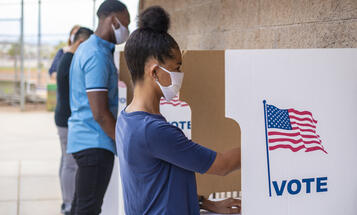
In the Dark About Voting Rights
Many people on public assistance do not know that it is federally mandated—under the National Voter Registration Act—that they receive the opportunity to register to vote every time they visit a public assistance agency to apply, re-certify or change the address on their benefits. One reason they are in the dark about this is because non-compliance with the NVRA is very common—a problem that helps keep low-income people marginalized from the voting process.
In Oklahoma, households with incomes above $100,000 register to vote at a higher percentage than households with incomes below $25,000. For the 2012 presidential election there was a 20% gap between these two groups. Non-compliance with the NVRA and, specifically, Section 7 of that law, is one of the reasons why this gap exists.
Between 2010 and 2012, public assistance agencies in Oklahoma received 11,122 voter registration applications—that’s a monthly average of 463 applications. The state of Mississippi, which has a comparable number of people receiving public assistance and is currently under a settlement agreement to comply with Section 7, received 32,109 applications during the same 2010-2012 period—its monthly average is 1,338 applications. Oklahoma is well below what their voter registration numbers should be and it is a problem that should be addressed. Recently, I traveled to Oklahoma to investigate this non-compliance and to assess what is happening at public assistance offices.
As I stood in line to conduct an investigation of the downtown Tulsa Department of Human Services office, I noticed that all of the signs in the office were in English. Oklahoma has a significant number of Latino immigrants and the fact that assistance may not be available in Spanish was unfortunate. The interviews I had conducted outside the office revealed that the majority of Spanish speaking people were not given the opportunity to register to vote at this office. For this reason, I decided to conduct my regular office investigation in Spanish.
One of the first things I noticed was that the lines waiting to speak to a clerk were uneven. The majority of the clients were in line to speak to a nice, young clerk who was very helpful and sweet. I stood in line at her window thinking there must be a reason why people only want to talk to her and there was. When my turn came to speak to this clerk, I said in Spanish that I needed assistance in Spanish. The clerk replied in broken Spanish that she couldn’t help me and pointed me to the window of the clerk with the short line.
I moved over to her window and waited to be called. The clerk was a middle aged Latina woman. When I first approached her, I requested a SNAP benefits application. She gave me one in English and I replied that I needed one in Spanish. She looked at me exasperated and replied in English: “You don’t speak English? Not even a little bit?” I replied in Spanish, “I don’t understand this application. I need Spanish”. To which she replied: “everything is in English here”. She got up and walked over to the counter and grabbed a SNAP application in Spanish. I reviewed the application and noticed there was no voter registration question or voter registration declination form as there was in the English application. I told her that I was new in town and wanted to register to vote. She handed me a form in English and I asked if I she had any in Spanish or if she could help me fill out the one in English. At this moment, she turned to another clerk sitting next to her and said something I could not hear. Then, facing my window she said: “They come here for benefits and don’t speak English. Lazy spics.” I couldn’t believe that a public employee had called me a racial slur. Was she aware that there are many naturalized U.S. citizens and legal permanent residents who have learning disabilities that prevent them from learning English?
I looked at the clerk, pretending to be confused about the forms she had just given me. When I was about to ask her for help filling out the form— assistance that is required to be given under federal law—she got up and went to the back of the office. I stood at her window for a few minutes waiting for her to come back but she did not. She went back to the windowand called the next person in line after I walked away. After this disturbing experience, I went back out the office and talked to a few more people but the majority of the clients were too annoyed to even stop at hello. I did see one Latina woman holding back tears as she exited the office. I wondered if the same rude and self-hating clerk had something to do with her distress.
The non-compliance with the NVRA paired with the horrible treatment of Latino clients in this office tell a compelling story about why further action to solve these issues is needed in the state. The state must comply with Section 7 of the law and make sure that all of their public assistance employees treat the clients with the respect they deserve.
****
As the field investigator at Demos, I travel to low income neighborhoods around the country and visit public assistance offices. In coming months I will be sharing more of my observations of what is like to be poor and on public assistance in America.


